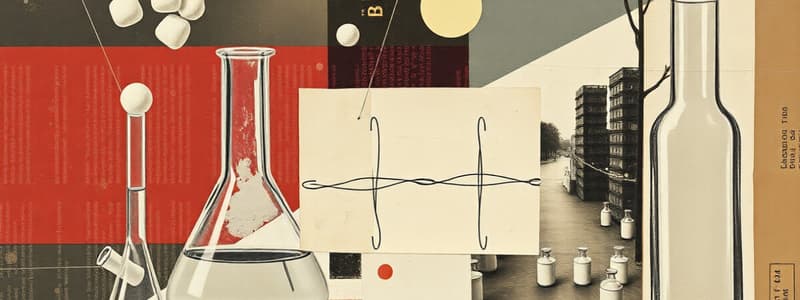Podcast
Questions and Answers
What is the primary structure that makes up proteins?
What is the primary structure that makes up proteins?
- Fatty Acids
- Nucleic Acids
- Carbohydrates
- Amino Acids (correct)
Which bond is responsible for linking amino acids together in a protein?
Which bond is responsible for linking amino acids together in a protein?
- Peptide bond (correct)
- Hydrogen bond
- Disulfide bond
- Ionic bond
Which of the following functions is NOT performed by proteins?
Which of the following functions is NOT performed by proteins?
- Enzymatic Activity
- Genetic Information Storage (correct)
- Muscle Contraction
- Defense (Antibodies)
What are the smaller units that link to form polymers called?
What are the smaller units that link to form polymers called?
Which process describes the breaking of polymers by adding water?
Which process describes the breaking of polymers by adding water?
What is the side group in an amino acid responsible for?
What is the side group in an amino acid responsible for?
What type of biological molecule is hemoglobin?
What type of biological molecule is hemoglobin?
What is the main role of enzymes in biochemical processes?
What is the main role of enzymes in biochemical processes?
Which element is NOT typically found in proteins?
Which element is NOT typically found in proteins?
What type of bond can carbon form with other atoms?
What type of bond can carbon form with other atoms?
What is the main element found in all organic compounds?
What is the main element found in all organic compounds?
Which of the following describes monosaccharides?
Which of the following describes monosaccharides?
Which carbohydrate is composed of three glucose units?
Which carbohydrate is composed of three glucose units?
What differentiates saturated fats from unsaturated fats?
What differentiates saturated fats from unsaturated fats?
What is a primary function of phospholipids?
What is a primary function of phospholipids?
Which of the following is NOT a characteristic of lipids?
Which of the following is NOT a characteristic of lipids?
What role do steroids play in the body?
What role do steroids play in the body?
Which organic compound is primarily responsible for structural support in plants?
Which organic compound is primarily responsible for structural support in plants?
What is formed when two monosaccharides bond together?
What is formed when two monosaccharides bond together?
Which of the following pairs correctly matches a carbohydrate with its form?
Which of the following pairs correctly matches a carbohydrate with its form?
Which function of proteins involves the transportation of substances in the body?
Which function of proteins involves the transportation of substances in the body?
What type of bond is formed between the amino group and the carboxyl group in amino acids?
What type of bond is formed between the amino group and the carboxyl group in amino acids?
Which of the following correctly describes the role of enzymes?
Which of the following correctly describes the role of enzymes?
What distinguishes amino acids from one another?
What distinguishes amino acids from one another?
Which term describes the process of forming larger molecules by removing water?
Which term describes the process of forming larger molecules by removing water?
What is the characteristic of carbon that allows it to form multiple types of bonds?
What is the characteristic of carbon that allows it to form multiple types of bonds?
In what way do proteins contribute to the structural integrity of tissues?
In what way do proteins contribute to the structural integrity of tissues?
Which molecule primarily serves as genetic material in living organisms?
Which molecule primarily serves as genetic material in living organisms?
Which of the following components is found in both DNA and RNA?
Which of the following components is found in both DNA and RNA?
What is the term for the smaller units that combine to form polymers?
What is the term for the smaller units that combine to form polymers?
What is the significance of carbon's structure in organic compounds?
What is the significance of carbon's structure in organic compounds?
What is the chemical composition ratio of hydrogen to oxygen in carbohydrates?
What is the chemical composition ratio of hydrogen to oxygen in carbohydrates?
Which type of carbohydrate is formed from two monosaccharides?
Which type of carbohydrate is formed from two monosaccharides?
What are the main components of fats?
What are the main components of fats?
What differentiates saturated fats from unsaturated fats?
What differentiates saturated fats from unsaturated fats?
What is the primary role of phospholipids?
What is the primary role of phospholipids?
Which of the following is a characteristic of chitin?
Which of the following is a characteristic of chitin?
What type of lipid is cholesterol classified as?
What type of lipid is cholesterol classified as?
Which carbohydrate is primarily used by plants for energy storage?
Which carbohydrate is primarily used by plants for energy storage?
Which of the following accurately describes the bond structure of saturated fatty acids?
Which of the following accurately describes the bond structure of saturated fatty acids?
Flashcards
Organic Chemistry
Organic Chemistry
The branch of chemistry dealing with organic compounds, primarily containing carbon.
Organic Compounds
Organic Compounds
Chemical compounds containing carbon.
Carbohydrates
Carbohydrates
Organic compounds with a 1:2:1 ratio of carbon, hydrogen, and oxygen.
Monosaccharides
Monosaccharides
Signup and view all the flashcards
Disaccharides
Disaccharides
Signup and view all the flashcards
Polysaccharides
Polysaccharides
Signup and view all the flashcards
Lipids
Lipids
Signup and view all the flashcards
Saturated Fats
Saturated Fats
Signup and view all the flashcards
Unsaturated Fats
Unsaturated Fats
Signup and view all the flashcards
Phospholipids
Phospholipids
Signup and view all the flashcards
Proteins
Proteins
Signup and view all the flashcards
Amino Acids
Amino Acids
Signup and view all the flashcards
Peptide Bond
Peptide Bond
Signup and view all the flashcards
Protein Functions
Protein Functions
Signup and view all the flashcards
Monomer
Monomer
Signup and view all the flashcards
Polymer
Polymer
Signup and view all the flashcards
Dehydration Synthesis
Dehydration Synthesis
Signup and view all the flashcards
Hydrolysis
Hydrolysis
Signup and view all the flashcards
Nucleic Acids
Nucleic Acids
Signup and view all the flashcards
Carbon's Covalent Bonds
Carbon's Covalent Bonds
Signup and view all the flashcards
Organic Chemistry
Organic Chemistry
Signup and view all the flashcards
Carbohydrates
Carbohydrates
Signup and view all the flashcards
Monosaccharides
Monosaccharides
Signup and view all the flashcards
Disaccharides
Disaccharides
Signup and view all the flashcards
Polysaccharides
Polysaccharides
Signup and view all the flashcards
Lipids
Lipids
Signup and view all the flashcards
Saturated Fats
Saturated Fats
Signup and view all the flashcards
Unsaturated Fats
Unsaturated Fats
Signup and view all the flashcards
Phospholipids
Phospholipids
Signup and view all the flashcards
Carbon's Structure
Carbon's Structure
Signup and view all the flashcards
Protein Building Blocks
Protein Building Blocks
Signup and view all the flashcards
Peptide Bond
Peptide Bond
Signup and view all the flashcards
Protein Functions
Protein Functions
Signup and view all the flashcards
Amino Acid Structure
Amino Acid Structure
Signup and view all the flashcards
Protein Monomers
Protein Monomers
Signup and view all the flashcards
Dehydration Synthesis
Dehydration Synthesis
Signup and view all the flashcards
Hydrolysis
Hydrolysis
Signup and view all the flashcards
Carbon's Bonding
Carbon's Bonding
Signup and view all the flashcards
Nucleic Acids Role
Nucleic Acids Role
Signup and view all the flashcards
Carbon's Atomic Number
Carbon's Atomic Number
Signup and view all the flashcards
Study Notes
Organic Chemistry
- Organic chemistry studies organic compounds.
- All organic compounds contain carbon.
- Many organic compounds come from living things.
- Most naturally occurring compounds are organic.
Carbohydrates
- Carbohydrates are organic compounds composed of carbon, hydrogen, and oxygen in a 1:2:1 ratio.
- Sugars and starches are examples.
- Living organisms use carbohydrates as an energy source and structural support.
Monosaccharides
- Simplest carbohydrates (simple sugars).
- Examples include glucose and fructose.
Disaccharides
- Two monosaccharides covalently bonded together.
- Examples include sucrose (glucose + fructose), lactose (glucose + galactose), and maltose (glucose + glucose).
Polysaccharides
- Large polymers composed of thousands of linked monosaccharides.
- Examples include starch, cellulose and glycogen.
- Starch: found in wheat, rice, corn, and potatoes; plants store glucose as starch.
- Cellulose: structural support in plants.
- Glycogen: animals store excess sugars as glycogen.
Lipids
- Lipids include fats, oils, waxes, and steroids.
- Generally composed of carbon, hydrogen, and oxygen, similar to carbohydrates but in different ratios.
Fats
- Composed of glycerol and three fatty acids.
- Used for energy storage and insulation.
- Excess carbohydrates are converted to fats for storage.
- Fatty acids are long chains of carbon atoms with an acid group at one end.
- The structure of fatty acids determines the properties of the fat.
- (Approximately 30 fatty acids in animals).
Other Lipids
- Phospholipids: Lipids containing phosphorous (phosphate); major component of cell membranes.
- Steroids: Composed of four linked carbon rings; examples include cholesterol and hormones that regulate bodily functions.
- Waxes: Organic compounds composed of fatty acids and alcohols, often used for protection or waterproofing.
Proteins
- Proteins are organic compounds composed of carbon, hydrogen, oxygen, nitrogen, and sometimes sulfur.
- Essential components of living organisms (muscles, hair, and skin).
- Proteins are polymers of amino acids.
Amino Acids
- Building blocks of proteins.
- Twenty different amino acids are used to make proteins.
- Amino acids are composed of an amino group (-NH2), a carboxyl group (-COOH), and a side group that determines the amino acid's identity.
- The bonds between amino groups form peptide bonds
Protein Functions
- Movement: Actin and myosin in muscle fibers.
- Structure: Collagen (connective tissue).
- Control: Enzymes that speed up chemical reactions.
- Transport: Hemoglobin (carries oxygen and carbon dioxide in the blood)
- Storage: Casein in milk stores amino acids for developing offspring.
- Regulation: Hormones that regulate growth, development, and metabolism
- Defense: Antibodies of the immune system
Nucleic Acids
- Large complex molecules composed of carbon, hydrogen, oxygen, nitrogen, and phosphorous (DNA and RNA).
- Genetic material.
- DNA (Deoxyribonucleic Acid): Stores genetic information in cells.
- RNA (Ribonucleic Acid): Assists in protein synthesis.
Studying That Suits You
Use AI to generate personalized quizzes and flashcards to suit your learning preferences.




